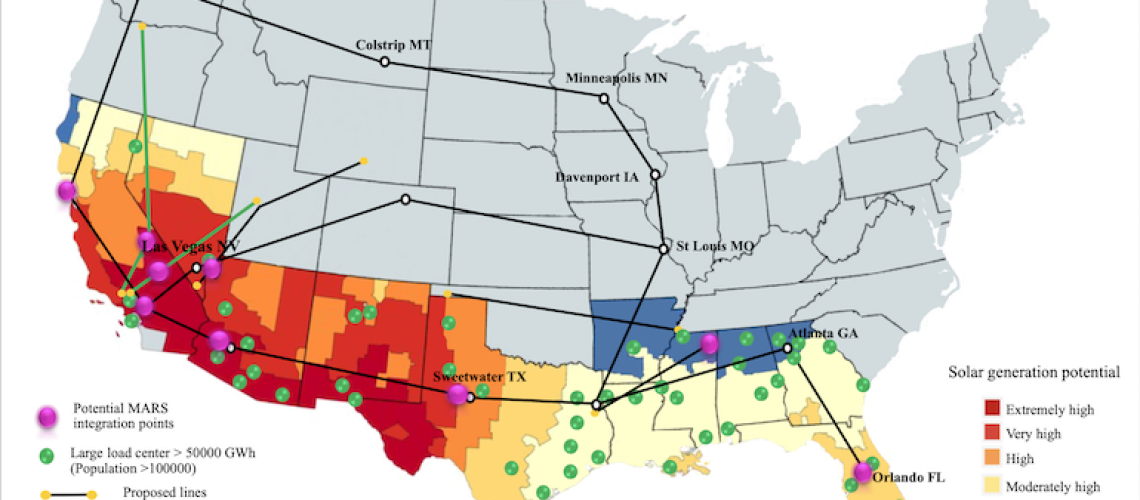This U.S. map shows existing and potential high-voltage direct current lines in states with the greatest solar generation potential, as well as prospective sites for multi-port autonomous reconfigurable solar power plants. Credit: ORNL, U.S. Dept. of Energy.
A team led by the Dept. of Energy’s Oak Ridge National Laboratory has developed a utility-scale design and control system for a hybrid solar power plant that can operate with both direct and alternating current — providing more flexibility, security and reliability than similar plants operating today. Hybrid plants include not only solar arrays, but also batteries, to store energy captured from the sun.
The multi-port autonomous reconfigurable solar power plant, or MARS, project integrates a complete suite of power electronics, electrical architecture and cybersecurity software in one package, simplifying deployment. ORNL and industry partners are working toward an initial field demonstration of MARS components that support grid stability or a scaled-down version of the full design.
The majority of the U.S power grid uses alternating current, or AC, which constantly switches the direction of electron flow. In contrast, solar arrays and batteries use direct current, or DC, flowing in a single direction. The American electricity transmission system includes a smaller number of high-voltage DC lines, which are more efficient at delivering bulk power over long distances or to remote regions. Converting current between DC and AC requires specialized power electronics.
ORNL researchers were challenged to find a cost-effective way to integrate large hybrid renewable energy plants that can provide power to both AC and DC high-voltage lines. This could support decarbonization goals by making it easier and more reliable to transfer renewable energy to distant cities with high energy demand.
Over the course of three years, an ORNL team led by Suman Debnath developed and enhanced a suite of power electronics, circuit architecture, control systems and cyber intrusion detection algorithms that work together as an integrated system. MARS can be easily scaled to different power levels and integrated with new solar and battery systems.
Southern California Edison has been a partner in the research.
“It matches our vision of the future,” said Md Arifujjaman, SCE’s senior engineer for grid technology innovation. “From the point of view of a good algorithm to track down cybersecurity problems and technology we can use on the DC side, MARS is very helpful.” He added that the DC technology is also promising for scaling down DC voltage for electric vehicle charging stations.
The project included innovations in a type of inverter that can maintain grid stability and jump-start the grid after a disturbance. This “grid-forming” technology could help prevent cascading power outages during the wildfires that plague California, Arifujjaman said.
In addition, MARS’s “one box” packaging of software, power electronics and architecture is attractive to utilities because it reduces both costs and time delays that arise from coordinating hardware development and installation.
The project team developed case simulations based on two specific sites in California. Simulations in hardware revealed the significant benefits of the ORNL-designed power electronics framework for the electric grid: up to 50% reduction in power loss, a 16% improvement in stabilizing AC voltage frequency, and 100% detection of cyber intrusions such as malicious sensor data.
The system was also more resilient because it could autonomously reconfigure itself based on available energy. For example, even at night when the solar panels were not generating electricity, MARS could continue to connect the AC and DC transmission systems and use stored battery power to supplement its operation.



